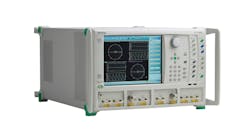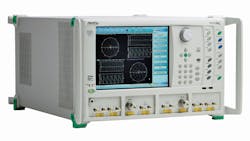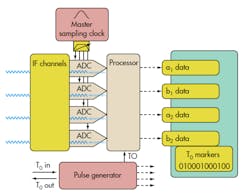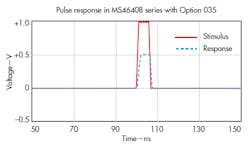Radar technology has long been associated with pulsed signals, and generating and analyzing such signals has long been a challenge to those supplying test equipment to architects of different radar systems, whether for military or commercial applications. With the growing use of radar technology in different markets, along with the established use of radar technologies in existing markets, comes the need to test these new radar systems, and Anritsu Co. has responded with its MS4640B series of RF/microwave vector network analyzers (VNAs)—an extension of the firm’s popular VectorStar family of VNAs.
Related Articles
• Design An ETSI E-Band Circuit
• LPF Builds On Quasi-Yagi DGS
• Modules Take The Place Of Full-Sized Instruments
The new analyzers include a host of automatic pulsed measurements, collectively known as the PulseView capabilities, which include pulse profiling, point-in-pulse measurements, and pulse-to-pulse measurements of the S-parameters for active and passive components under test. The analyzers offer measurement capabilities over bandwidths as wide as 70 kHz to 110 GHz from a single coaxial port, while the optional PulseView measurement capabilities can show pulse resolution of 2.5 ns across a dynamic range of 100 dB.
The latest additions to the VectorStar family of VNAs include the MS4640B series instruments, with available optional PulseView pulsed measurements. (The VNAs also offer optional DifferentialView test capabilities, for users grappling with high-speed serial-bus measurements.) An example of the new VNA line is the model MS4647B (Fig. 1), with broad frequency range of 10 MHz to 70 GHz; other members of the VNA family include models MS4642B (10 MHz to 20 GHz), MS4644B (10 MHz to 40 GHz), and MS4645B (10 MHz to 50 GHz).
In terms of their traditional VNA continuous-wave (CW) measurement capabilities, these analyzers offer impressive performance capabilities, with receiver dynamic ranges of 115 dB or better from 2 MHz to 50 GHz and better than 113 dB from 50 to 70 GHz. The receiver 1-dB compression in standard model is +5 dBm through 0.3 MHz and +10 dBm from 0.3 MHz to 70 GHz, with higher compression points available as an option. The VNA noise floors drop to -105 dBm from 2 to 10 MHz and -110 dBm from 10 MHz to 70 GHz, while the available test signal power is +12 to -25 dBm from 10 MHz to 2.5 GHz, +5 to -25 dBm from 2.5 to 50 GHz, and at least -3 to -25 dBm through 70 GHz.
However, these are not just traditional VNAs. When equipped with Option 035 and Option 042 (PulseView™), the MS4640B series VNAs include the capabilities to generate and analyze fast pulsed signals. The pulsed generation/analysis capabilities support 2.5-ns pulse resolution across a 100-dB dynamic range for all frequencies in the MS4640B range through 70 GHz.
Without the options, analyzed signals are frequency downconverted and processed within the intermediate-frequency (IF) section of each VNA. In normal operation, an MS4640B VNA uses an IF with 100-MHz bandwidth and filtering to minimize large image signals. With options 035 and 042, the standard IF system is bypassed and signals are routed to a special high-speed-digitizing IF board with greater than 200-MHz acquisition bandwidth (Figs. 2 and 3). This board consists of analog processing (filtering, gain, calibration, etc.) with the much wider bandwidth than the standard analog IF circuitry, to equip it for measuring very narrow pulses. The digitizing board contains high-speed analog-to-digital converters (ADCs), pulse generators, and digital-signal-processing (DSP) components for pulse generation and analysis. The digitizers enable data acquisition rates to 400 MSamples/s within the VNAs, making possible the 2.5-ns time resolution. Each VNA is supported by deep acquisition memory depths (4 GB) to enable capture of time records of more than 0.5 s with full resolution. The four internal pulse generators are independent of the measurement channels and can be used for RF/microwave stimulus modulation, for modulating bias circuitry, or other applications within a test setup.
Additional Features
Each MS4640B VNA features four independent receiver measurement windows or gates that help establish reference position/timing control to correct for transients or any path delays or timing issues during pulsed measurements. Pulse triggering latency is minimized in the MS4640B VNAs by using the high-speed digitizer card and performing post-processing alignment with the captured pulse data. Pulse measurements are aligned by means of an internal synchronization signal to achieve pulse measurement jitter and latency on the order of picoseconds. Latency will only extend to a range of tens of nanoseconds when using an external synchronization signal
This type of low jitter and high resolution enables the MS4640B VNAs to measure narrow-pulse-width signals with very fine resolution, including the analysis of intra-pulse behavior and even the study of rise/fall edge effects within a pulse compression signal. Except for pulse-to-pulse measurements, pulse acquisitions are not constrained by the real-time synchronization of the digital IF pulse measurement circuitry. The digitizer captures and records pulsed signals for analysis and correlates the captured data with any pulse patterns generated by the VNA.
With the PulseView capabilities, the MS4640B series VNAs provide a variety of different pulsed measurements, including point-in-pulse, pulse-to-pulse, and pulse-profiling capabilities. Details on the different pulsed measurements are provided as part of the on-screen Pulse Setup menu. The point-in-pulse measurements are suitable for close scrutiny of individual pulses, quantifying S-parameter data at any point in time within a pulse. These measurements are made with swept frequency or swept power levels and plotted according to the test signals. These measurements are made over a desired interval of interest relative to a synch pulse (T0), with the interval usually quantified in terms of a delay (T1) and a measurement window. By adjusting the delay of the measurement window, the startup effects of certain components under test can be avoided. The minimum measurement window is determined by the inverse of the IF bandwidth window, or 1/IF bandwidth (1/200 MHz or about 2.5 ns).
Pulse profiling measurements are effective for examining data within a pulse, such as pulse overshoot and undershoot, pulse droop, and rise and fall times. These measurements are typically made in the time domain, with frequency and power levels kept constant. With the high-speed digitizers of the MS4640B VNAs, pulse-profiling measurements can be performed by means of a single signal acquisition, with data sequentially processed using the selected measurement width at each of the requested time points. When applying averaging, it will be necessary to make multiple measurements over multiple pulses.
Pulse-to-pulse measurements are useful for quantifying variations from pulse to pulse in a pulse stream. As with pulse profiling measurements, these measurements are also made in the time domain, with frequency and power levels kept constant. Pulse-to-pulse measurements can reveal when a pulse’s characteristics are varying over time, such as thermal effects in power amplifiers or variations in amplitude and/or phase in a high-frequency circuit or component.
Not to be overlooked, the DifferentialView option in these new VNAs, together with an optional internal second source, provides the specialized differential test signals needed for those working on differential amplifiers or signal-integrity (SI) issues to evaluate their circuits under realistic operating conditions. This optional measurement capability provides real-time display of differential devices and components, while being able to actively modify the magnitude and phase relationships of the two internal (differential) test signal sources. When used with the company’s four-port test sets, DifferentialView allows measurements of differential, common mode, and mixed-mode S-parameters. The testing capability is backed by an innovative graphical user interface (GUI) on the VNAs that allows operators to make quick changes to signals and see results immediately without changing on-screen displays.
Related Articles
• Design An ETSI E-Band Circuit
• LPF Builds On Quasi-Yagi DGS
• Modules Take The Place Of Full-Sized Instruments
The MS4640B series of RF/microwave VNAs are available in standard models through 70 GHz and in models with coaxial coverage as wide as 70 kHz to 110 GHz at a single 1-mm connector. For even higher-frequency measurements, frequency coverage to 750 GHz can be achieved by using millimeter-wave frequency-extension modules from Virginia Diodes (VDI) or Oleson Microwave Labs (OML, Inc.), depending upon the particular frequency range required. P&A: starting at $76,325 (MS4640B VNAs), $30,000 (PulseView option), $15,000 (IF digitizer option), $11,270 (second source option), and $10,150 (DifferentialView option); 8 to 10 wks.
Anritsu Co., 490 Jarvis Dr., Morgan Hill, CA 95037-2809; (408) 778-2000, FAX: (408) 776-1744.



